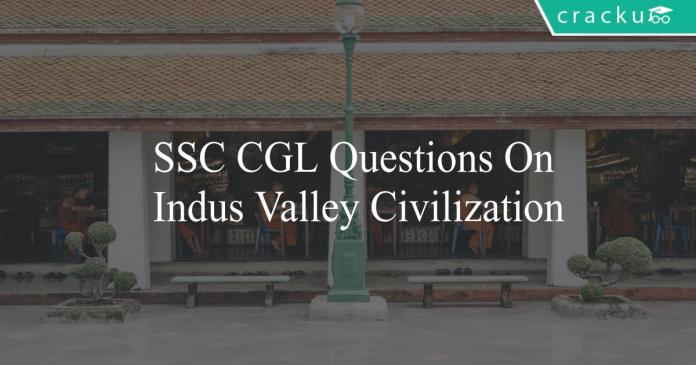SSC CGL Questions On Indus Valley Civilization
Download SSC CGL Indus Valley Civilization questions with answers PDF based on previous papers very useful for SSC CGL exams. 12 Very important Indus Valley Civilization objective questions for SSC exams.
Download SSC CGL Questions On Indus Valley Civilization
Instructions
A passage is given with five questions following it. Read the passage carefully and select the best answer to each question out of the given four alternatives.
Culture is defined as a people’s way of life. It entails how they dress, how they speak, the type of food they eat, the manner in which they worship, and their art among many other things.
Indian culture, therefore, is the Indian’s way of life. Because of the population diversity, there is immense variety in Indian culture. The Indian culture is a blend of various cultures in the world. India had an urban civilization even during the Bronze age. The Indus Valley Civilization (Harappan Civilization) dates back to 3300 BC – 1300 BC. Distinct cultures different from each other co-exist together in a single country. Thus, in India, there is unity amidst vast cultural diversity. The way people live in India is reflected in its culture.
Unity in Diversity: India is a land of unity in diversity where people of different sects, caste and religion live together. India is also called the land of unity in diversity as different groups of people co-operate with each other to live in a single society. Unity in diversity has alo become the strength of India.
Secularism: The word secularism means equality, impartiality, etc, towards all religion. India is a secular country, which means, equal treatment of all the religions present in India.
Traditions: traditional cultural values
1) Touching feet of elders: Indian tradition has rich cultural values. In India, younger show great respect to their elders. They touch the feet of their elders daily after waking up and especially on the festive occasionally on the festive occasions or before starting an important work.
2) Namaste: The gesture of the Namaste greeting is also part of the Indian culture. People greet each other by saying “Namaste” while joining their hands. “Namaste means “Hello”. (Also read. The meaning of Namaste here.)
3) Most Indians have a habit of shaking their heads while talking.
Question 1: What is the reason behind the immense variety in Indian culture ?
a) Blend of various cultures
b) Population diversity
c) Cultural diversity
d) Secularism
Question 2: Based on the above passage, which of the following is NOT true about Indian culture ?
a) Indian culture dates back to 3300 BC – 1300 BC
b) Every religion follows their own tradition and customs.
c) Every religion is treated equally in India.
d) In India there is unity in diversity.
Question 3: Which of the following is not true according to the passage ?
a) Culture entails how people dress.
b) Culture entails how people speak.
c) Culture entails how people worship.
d) Culture entails what drawing people draw.
Question 4: Why is India called a unity in diversity ?
a) Different groups of people co-operate with each other.
b) People of different sects, caste and religion live together.
c) It is strength of India.
d) All of these
Question 5: If I am a cultural, well-behaved Indian, what won’t do ?
a) Touch the feets of the elders.
b) Join my hands while doing ‘Namaste’.
c) Wake up early in the morning, especially on the festive occasions.
d) Shake my head as a habit while talking.
Question 6: Which historian is of the opinion that the decline of Indus Valley Civilization is due to Aryan invasion?
a) Robert Raikes
b) M.Wheeler
c) Dayaram Sahani
d) R.D.Benerjee
Question 7: Indus valley civilization flourished in which period?
a) 2600 – 1900 B.C
b) 1000 – 750 B.C
c) 3500 – 2500 B.C
d) 1600 – 1000 B.C
Question 8: Which ancient city of Indus-Valley Civilization was famous for its dock yard?
a) Dholavira
b) Lothal
c) Chanhudaro
d) Mohenjo-daro
Question 9: The houses of the Indus Valley Civilization were built using?
a) Bamboos
b) Wood
c) Bricks
d) Stone
Question 10: Indus Valley Civilization was a __________ age civilization.
a) Silver
b) Tin
c) Gold
d) Bronze
Question 11: Lothal, the dockyard site of the Indus Valley Civilization, is situated in
a) Gujarat
b) Punjab
c) Pakistan
d) Haryana
Question 12: The people of indus valley civilization worshipped:
a) Brahma
b) Vishnu
c) Pashupati
d) Indra and varun
18000+ Questions – Free SSC Study Material
Answers & Solutions:
1) Answer (B)
2) Answer (B)
3) Answer (D)
4) Answer (D)
5) Answer (C)
6) Answer (B)
7) Answer (A)
8) Answer (B)
9) Answer (C)
10) Answer (D)
11) Answer (A)
12) Answer (C)





